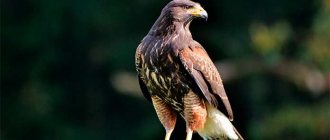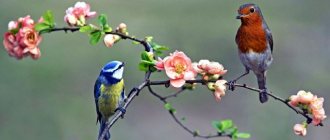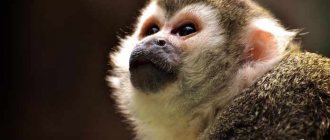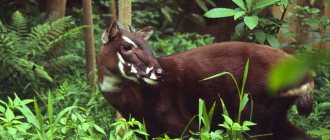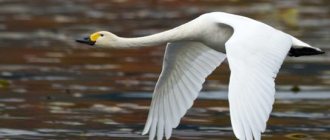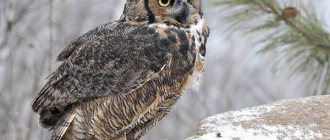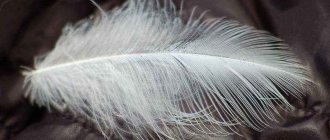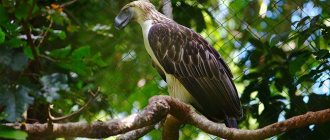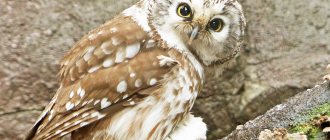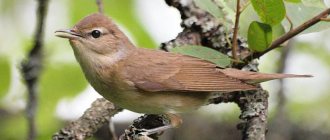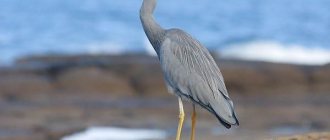Diversity of tundra birds. Read all about their habits and appearance in this article.
Only some tundra birds do not leave this endless snowy plain in winter. In the winter months, frosts in the tundra are about 50 degrees, and a snowstorm can rage for a whole week, from which trees do not protect. Trees in the tundra simply cannot grow tall, due to the fact that the soil layer is very thin (15-25 centimeters) and it lies on permafrost.
tundra birds that people can see in winter in these parts:
- Polar owl, with beautiful white plumage.
- Common raven.
- White partridge.
Interestingly, similar birds live in the harsh conditions of the Sahara: the raven, the eagle owl and birds of the partridge genus. They are completely different, they have brown feathers and are smaller in size. The further north a bird lives, the larger it is in size.
White-billed loon
Photo source: Mark Peck/flicr
White-billed loons are the largest waterfowl. In appearance they resemble geese. Males are larger than females and their body length can reach up to 1 m. The wingspan of this bird is on average 150 cm. The main habitat is the coast of the Barents and White Seas. Often found in Novaya Zemlya and northern Canada.
The nesting grounds of loons are located in the Arctic tundra (on the mainland coast of northern Russia). White-billed loons build nests from arctic grasses near freshwater lakes. For the winter they fly to the north of Norway, to Sakhalin and the Kuril Islands. The Canadian population winters in southern Alaska and California.
2
Birds of the Arctic
Usually, when talking about the fauna of the Arctic, birds are not the first thing that comes to mind. And yet it is the birds that give the white silence of this region a special charm. The ringing song of the polar sparrow - snow buntings
Plectrophenax nivalis represents the arrival of real spring in the Arctic.
Its appearance at polar stations is the same as the arrival of rooks and starlings in the villages of central Russia. The black-and-white bird is perhaps the only representative of song passerine birds in the polar regions. This tiny traveler was carried by evil winds to the North Pole. Usually the bunting feeds on plant seeds, but it needs to feed its small chicks on insects. Where can you get them in the Arctic? Of course, there are several types of mosquitoes here. There are even those who are unable to fly due to undeveloped wings. There are very, very many of them... but only on warm days. Buntings have to make a lot of effort to feed their offspring to the full even during cold weather - for example, by collecting free-living nematodes in the snowfield.
On the Arctic islands, even far from the mainland, you will even meet a brood of tundra partridge
Lagopus mutus. It seems that these birds, typical inhabitants of the mountain tundra, do not belong here. But the sparse vegetation, crushed by frost and harsh winds, turns out to be quite sufficient for the existence of these representatives of the gallinaceae. They cannot survive here in winter. It’s hard to imagine how much effort it takes for these birds to reach the mainland.
Male tundra partridge on the nesting site.
And yet, mainly the feathered kingdom of the Arctic thrives at the expense of the sea. The vast majority of northern birds are its typical inhabitants. On land they appear only for nesting and raising chicks. The location of bird nesting sites is determined here mainly by the availability of safe nesting sites and available food resources. When choosing a breeding area, the last factor is decisive. For birds that have close food connections with marine ecosystems, nesting areas are confined to marine areas with increased biological productivity - for example, to frontal zones or marginal zones of drifting ice. At the same time, many species of birds are so adapted to the marine environment, to the aquatic lifestyle and to diving to great depths that they feel insecure on land and are forced, even during the breeding season, to obtain absolutely all the food for their chicks in the sea.
Typically, marine bird species use all food sources available to them in the sea, developing specific adaptations that facilitate their prey. They can be planktivores, ichthyophages and feed on benthos. Omnivores are also found among seabirds.
Representatives of petrels are fulmars
Fulmarus glacialis - with the help of long narrow wings, they soar for a long time in air currents above the sea surface. In flight, they search for large accumulations of zooplankton, simultaneously using other objects for food, including fishing waste. With their beak and upper beak, armed with a curved sharp hook, they are capable of tearing the skin of dead animals found in the sea.
A light color variant of the fulmar. Narrow long wings make it easier for the fulmar to fly in air currents, but make it difficult to land and take off from the water in calm weather.
In exceptional cases, fulmars can also attack small species of gulls, such as the kittiwake Rissa tridactyla, tearing out pieces of muscle from living birds with their beaks.
When a source of food becomes available to fulmars, they accumulate in a given area of the water area. The downside of the colonial way of life is increased aggressiveness towards one’s neighbors.
In the water column, auks hunt for small fish. Due to their short and narrow wings, they are not distinguished by any virtuoso flight in the air - although they fly quickly, they are not able to maneuver. But their wings, when bent, allow them to fly underwater and effectively pursue prey in the water column. In the Arctic seas, the most numerous species of auk bird is the thick-billed guillemot.
Uria lomvia. On land, guillemots move with difficulty; their webbed paws are not adapted for this, but in the air and during underwater flight they act as rudders. And one more thing: the webs of the paws, pierced with blood vessels, serve as an excellent heating element when incubating eggs.
The structure of the wings allows the guillemot to dive excellently, but when trying to land on its own piece of rock, it experiences difficulties. It often misses, especially in calm weather.
Guillemots choose breeding sites on rocks inaccessible (or almost inaccessible) to four-legged predators, where the bird lays a single pear-shaped egg.
During the entire incubation period, guillemots hold it on their paws, covering it from above with their body, in the plumage of which during this period a bare patch of skin appears - the brood spot. These birds do not build nests, but when changing partners, they roll the egg from paw to paw. And only if the incubating parent is frightened can the egg end up on a rock, often covered with ice. Guillemots often nest on sloping rocky areas, where such transfer from paws to paws is the only way to preserve the egg.
Guillemots try to nest side by side, but even among them there can be individualists.
It is noteworthy that the eggs do not have camouflage coloring. In the presence of various spots, specks and “squiggles”, the general background color can be white, bright green or dull bluish shades. The constant presence of one parent reduces the importance of egg coloration for protection from predators. Guillemots are obligate colonial birds; they can nest and reproduce normally only in colonies, that is, in clusters of birds of their own species. For normal reproduction, they need to hear calls (acoustic background) and see (visual background) birds of their species. This is probably why the booming cries of guillemots can be heard far across the surrounding area. This method of nesting in dense colonies reduces the possibility of death of offspring from the activities of feathered predators, which in high latitudes include, primarily, large gulls. During rockfalls, landslides, and unsuccessful flights, guillemots are often injured and even die. Arctic foxes hunt them near the colonies.
It is generally believed that the pear-shaped shape of the egg is associated with the nesting of birds on rocks and prevents the eggs from rolling off in the event of birds flying off. This is not entirely true. Anyone who has worked in guillemot colonies is well aware that when birds fly away due to a sudden fright (collapse of a rock, sound signal from a ship, etc.), a massive fall of eggs from the rocks is observed. When pushed, a freely lying egg still moves in a gentle arc. The pear-shaped shape of the egg in this case does not help the birds at all.
During the period of mass laying of eggs by guillemots, arctic foxes climb to the edges of the colonies and steal them. Some of the eggs are hidden for future use.
But this form is optimal for this method of incubation, when the egg is on the bird’s feet. Special experiments have shown that in areas densely populated by guillemots, birds are able to recognize an egg that has moved in an arc within a diameter of 50-70 cm as their own. The birds cannot recognize an egg that has rolled out beyond these limits as their own and throw it away. Successful breeding seasons for guillemots do not happen every year. Feathered chicks, not yet capable of flight, leave the colony by jumping into the sea, often from a great height. The underdeveloped flight feathers of the wing, with frequent flapping, allow them to soften the blow to the water, where they are met by an invitingly screaming male. From the moment the fledgling splashes down, he takes full care of it. But in cold years, when the sea around the colonies is clogged with ice, the chicks may not reach open water. During these seasons, mass death of offspring occurs.
The chicks descend onto the water, not yet capable of flight . In cold seasons, to get to open water, they have to make a long trek across ice fields. In this dangerous enterprise they are accompanied and protected by the male.
In Arctic latitudes, the main food of thick-billed guillemots is pelagic fish (most often polar cod) and small crustaceans. In pursuit of food, guillemots are capable of diving to great depths, significantly exceeding one hundred meters. But most often they find accumulations of available food in shallower layers of water. It is still not clear how guillemots identify prey in the absence of light at great depths or in surface waters during the polar night. Studies of the structure of the guillemot's eyes have shown that they are not adapted for night vision. Concerns are often expressed that, as the Arctic warms, the food supply of guillemots will change so much that this will lead to the degradation of their colonies. However, so far in colonies where the number of birds is controlled, in recent years there has been no decrease in nesting guillemots; on the contrary, in some colonies it is increasing. Due to methodological difficulties, it is very difficult to estimate the total number of thick-billed guillemots living in the Arctic, but it is clear that at present it may amount to several million individuals.
Broods of guillemots gather to rest even in small areas of water, allowing them to get a short respite from attacks by predators.
Along with thick-billed guillemots, the Arctic is home to another widespread species of auks, the little auk
Alle alle. It is a specialized consumer of zooplankton. Small black and white birds, weighing only 200-250 g, inhabit rocky screes like fairy-tale gnomes. There, in the crevices, among the stones, they set up a primitive nesting chamber, where, in the absence of any lining, their only bluish egg is located.
Little auk colony on the island. Hooker of Franz Josef Land.
In such nesting conditions, neighbors do not see each other, so they regularly hold mass gatherings on the highest talus stones. Such places are usually called “clubs”.
The little auk is a colonial species of bird and feels normal only in the company of its own kind.
Another method of communication that little auks resort to is constant vocalization. The birds continuously emit piercing trills, which make it quite easy to detect their colony. The social activity of little auks is uniquely manifested in specific circular flights - “carousels”. There is an assumption that in this way, at the very beginning of the season, the birds synchronize the reproduction of individual pairs in the colony, and young individuals visiting this scree for the first time select a place for future nesting and get to know their neighbors.
The closed nesting method and the extremely high social activity of birds cause significant difficulties in counting birds in colonies. As a result, the number of little auks in settlements is determined with rough tolerances during regular counts of individuals in “carousels” and in colonies. The total number of little auks in the Arctic can be estimated at several million individuals.
Little auks swim and dive well, catching dense accumulations of the pelagic crustacean Calanus. It is saturated with fat and is a high-calorie food. But the calanus is very small, and little auks are forced to catch it until the sublingual sac is completely filled. They do not have special devices (straining and filtering) for mass catching of crustaceans. The birds probably stuff their sublingual sac with prey, grabbing the crustaceans one at a time. It follows that this method of hunting can only be effective in very dense concentrations of prey.
The little auk brings the caught crustaceans to the chicks in the sublingual pouch. With the help of such outgrowths on the palate, it holds the Calanus crustaceans when caught.
Little auks are a real decoration of the Arctic, enlivening its coastal areas with their polyphony. After the chicks land on the water, which will also be accompanied by males until they fly, the colonies quickly become empty, and silence hangs over the rocky scree.
Ritual courtship of little auks.
Another representative of the Chistikov family, in fact, who gave him the name - that’s what the guillemot
Cepphus grille. Unlike guillemots and little auks, guillemots do not nest in large colonies. Their sparse settlements usually consist of several pairs and very rarely reach several dozen individuals. Birds lead a secretive lifestyle. In the first half of summer, their presence can be recognized only by manifestations of social activity on the water in quiet evenings and nights. Guillemots gather in groups and demonstrate elements of mating behavior. They make their nests in cracks and crevices of rocks along the edges of bird colonies, less often in rocky screes.
As a rule, guillemots lay two eggs. The hatched chicks are fed with small bottom fish, crustaceans and polychaetes. Fully fledged young guillemots, left behind by adults, go to the water and immediately begin to lead an independent lifestyle.
An immature guillemot caught a polychaete.
One of the classic representatives of the Arctic avifauna and important formative elements of bird colonies is the small kittiwake gull
. It is often called the three-toed gull (only three fingers are fully developed) and the black-footed gull. But in Russian ornithology, its Pomeranian name – kittiwake – has taken root. She got it on the Murmansk coast of the Kola Peninsula, where in a food sense it is closely related to capelin. The population of Murman, who actively collected bird eggs, noticed a characteristic feature: during capelin harvest years, kittiwakes nest in bird colonies in large numbers, and in their nests there are often clutches of two or three olive-brown eggs.
In the Arctic regions of the Barents Sea, capelin appear infrequently, and kittiwakes obtain other food there. But it is extremely rare to see a complete clutch of three eggs in kittiwakes in these areas. Usually it is one or two eggs here. The average clutch size of kittiwakes is an excellent indicator of the birds' food supply during the pre-breeding period. In seasons when the availability of food for kittiwakes is severely limited, the phenomenon of non-nesting is observed. In this case, most of the kittiwakes occupy the colony, often even restoring nests, but do not begin laying eggs.
The kittiwake is also an obligate-colonial species and can reproduce normally only in groups with a minimum of 10-20 pairs of its species. It was not for nothing that they called her the talker. In the colony, the birds lead an active lifestyle, constantly screaming and conflicting with their neighbors.
In the colony, kittiwakes are characterized by demonstrative behavior, which often immediately turns into scandals between neighboring pairs.
At the same time, these scandals and demonstrative behavior in the colonies have their own biological meaning. This activity helps to synchronize the reproduction of birds in the colony. The birds make their nests on the ledges of steep rocks, using remnants of vegetation, moss and mud as building materials. The birds incubate the clutch one at a time and sit very tightly. In Arctic regions, where the feeding capabilities of birds are limited (birds fish only the surface layer of the sea), distinct differences in the foraging behavior of the sexes are observed. Males make long search flights. Their prey is often small fish, mainly cod. Females leave the nests for a shorter period of time. Most often, they feed near glaciers and nearby ice fields, where zooplankton immobilizes and accumulates at the junctions of fresh melt water and salty sea water. This is what female kittiwakes most often feed on.
At the junction of sea water and fresh runoff from melting glaciers, immobilized zooplankton accumulates, which kittiwakes constantly feed on.
It is clear that in cold seasons, when the spaces around the colonies are filled with ice, kittiwakes have to spend much more time foraging for food. The chicks get much less of it, and the phenomenon of socially determined mortality appears in the colonies. Chicks fight for access to food, and, as a rule, the strongest and most aggressive chick wins. Fully feathered kittiwake chicks gradually leave their native colonies and form flocks consisting almost exclusively of young birds. A warming Arctic will likely provide kittiwakes with more abundant, high-calorie food, and their numbers in the region will increase. Currently, in the Russian sector of the Arctic, the number of kittiwakes can reach a million individuals.
A young kittiwake has just left its parent's nest.
But the real symbol of the Arctic is still another gull – the white gull Pagophila eburnea
. Of all seabird species, it is the one most closely associated with ice. The breeding area of the ivory gull is located within homogeneous ice areas and is limited by the ice regime and seasonal ice conditions of the sea. The determining factor for choosing a nesting site for an ivory gull is the absence of four-legged predators – arctic foxes. For breeding, it prefers coastal tundras, low-lying areas of islands near glaciers or sea ice.
The entire life of gulls is connected with Arctic ice; they even form colonies near glaciers.
Unlike kittiwakes, the ivory gull is a facultative-colonial species of seabird. In fact, it can reproduce normally both in colonies of its species and in separate pairs. Existence in the harsh conditions of the Arctic has left its mark on ivory gulls. They are characterized by high interannual fluctuations in the number of nesting birds, the abandonment of colonies and the formation of new ones during one season, and a radical change in nesting sites. In favorable years, early breeding periods, a high density of nesting birds and the presence of clutches of three eggs are noted.
The white gull is an omnivorous species. Among the ice in the sea, she catches cod and crustaceans. Actively feeds on animal corpses, picks up leftover food from polar bears and their excrement. Often these birds visit landfills near residential settlements, looking for food waste. Cases of cannibalism are also typical for them.
During the research of the Russian scientist M.V. Gavrilo, in recent years in the Russian sector of the Arctic, the number of ivory gulls was determined to be 11-13 thousand pairs. It was not possible to identify any pronounced trends in the development of the Russian population. But it is known that there are very real threats to this species, primarily organochlorine pollution. Ivory gulls have one of the highest levels of these chemical compounds among Arctic birds. One of the possible threats to ivory gulls may be the warming factor in the Arctic regions. For these reasons, the species is included in the Red Book of the Russian Federation and the Red List of the International Union for Conservation of Nature.
White gull chick at the nest
Burgomaster
Larus hyperboreus – this species of gull is one of the largest seabirds in the Arctic. Distributed circumpolarly. The glaucous glaucous is a facultative colonial species of seabird. Breeds in single pairs and sparse settlements. Prefers to choose nesting sites near colonies of other bird species or at river mouths. Large colonies, up to a hundred pairs or more, are rarely formed, as a rule, only in areas rich in available food.
The glaucous glaucous is omnivorous. In the sea among the ice it catches cod and crustaceans. Uses dead animals, industrial waste, and food waste near residential premises for food. In bird colonies, it actively destroys nests and steals chicks.
The burgomaster who stole an egg from a guillemot. He can swallow such an egg whole.
If necessary, the glaucous guillemot is capable of catching adult guillemots, kittiwakes and guillemots. Cases of cannibalism are typical for the burgomaster. In Arctic seabird colonies it is the main feathered predator.
The glaucous guillemot is capable of catching an adult kittiwake and even a guillemot. But more often it uses injured and dead birds for food. A pair of glaucous guillemots near a dead thick-billed guillemot.
It builds massive nests from plant remains on the coasts on the tops of large stones, in bird colonies along the periphery of the colonies. A complete clutch consists of three olive-brown eggs with dark spots. Nests are actively protected from terrestrial predators.
During a vertical dive, it can hit the violator of the boundaries of the nesting area (Arctic fox, human, etc.) with its paws. The chicks are successfully fed with any food available in the nesting area.
The burgomaster had a hearty lunch.
In many areas of the Arctic, during the breeding season you can meet a seabird with a unique lifestyle - the short-tailed skua
Stercorarius parasiticus. This close relative of gull birds, a prominent representative of the Skua family, is distributed circumpolarly in the Arctic regions. Using masterly maneuverable flight, the skua has adapted to catch small birds and take food from other birds. At the beginning of the 20th century, the Pomors called him “robber”, “fomka”, “police officer”. These names reflected the thieving and predatory nature of the bird's behavior.
The Short-tailed Skua nests in low-lying areas of coastal tundra, most often in solitary pairs. Spends a lot of time in the air, playing catch-up games. Flights are accompanied by characteristic screams, vaguely reminiscent of the screams of cats. Each pair occupies a certain territory, which it actively defends both from third-party birds of its own species and from other border violators, including humans.
The skua actively defends the nesting territory from enemies, often striking the intruder with its paws.
When a predator appears, it either attacks, striking with its paws in a dive, or actively imitates a wounded animal, accompanying its demonstrative behavior with a “chick’s” squeak.
The nest is an unremarkable hole in the ground without any lining. A complete clutch consists of two olive-brown eggs. As easy as it is to spot skuas themselves in the area of their site, it is just as difficult to spot their nest or hidden chick in the area.
The masterly maneuverability of the flight of the short-tailed skua contributed to the formation of a unique method of hunting. In the southern Arctic regions, where small passerines and waders are quite common, he hunts for these birds. It carries caught prey or an egg stolen from someone else's nest in its paws. Its paws are typical of gull birds, but are armed with sharp curved claws. In these situations, the short-tailed skua acts as a typical ornithophage. In coastal areas, where the number of other species of seabirds is high, it uses a unique method of obtaining food - kleptoparasitism. Simply put, theft. Having discovered a bird with prey, it chases it, literally driving it until the victim regurgitates the prey. Skuas often catch burps on the fly. Among its victims are kittiwakes, guillemots, and less commonly guillemots, and very rarely young glaucous guillemots are attacked.
It is problematic to estimate the actual number of short-tailed skuas in Arctic regions. It is unlikely that it exceeds several tens of thousands of breeding pairs. There are currently no significant threats to populations of Short-tailed Skuas.
Among Arctic birds, few species contain the term “polar” in their names. These include the Arctic tern
Sterna paradisaea. In the Arctic zone, the Arctic tern has a circumpolar distribution. Of all the terns, this is the most northern species. The appearance of the Arctic tern is memorable - a small white-gray bird with a dark cap, scarlet beak and legs, characteristic sharp wings and a “swallow” tail. Like all colonial birds, it is “talkative”. The species-specific cry of the Arctic tern, “Kirrya-ya-ya,” can be constantly heard over its nesting area. Actively protects its offspring, striking with its sharp beak when attacking.
Breeds in low-lying areas. The nest is an ordinary hole. The maximum clutch size is three eggs. Sometimes clutches with four and five eggs are found, but in these cases they may well be double clutches.
The Arctic Tern feeds on small objects: small fish and various forms of zooplankton. Looks out for prey in the water column, hovering over it with characteristic fluttering wing beats. Having discovered prey, it tries to catch it during a “shock dive.”
Arctic terns catch fish and small crustaceans. After a hasty dash, the tern flies away with an amphipod in its beak.
The hunting method raises the question of whether Arctic terns have polarized vision (this is the ability to see objects in the water at different lighting angles, despite glare and reflections) and the need for sufficient illumination of the feeding area. It leaves the nesting areas in early August, perhaps the first of the entire complex of Arctic birds. In mid-August, birds appear in the vast North Atlantic. The Arctic tern gained public fame due to the length of its migration routes and the remoteness of its wintering areas. Arctic terns spend the winter in Antarctic waters. The average length of their migration routes during one annual cycle, according to Russian researcher A.E. Volkov, amounted to more than 84 thousand km, and the duration of wintering in the Antarctic regions was more than 120 days.
Downy Arctic Tern chick
Among the seabirds of the Arctic there is also a famous species of sea duck - the common eider
Somateria mollissima. Distribution is circumpolar. The large sea duck (weighing about two kg) has pronounced sexual dimorphism.
A male eider in a contrasting, revealing plumage.
The common eider is an excellent diver, although it does not demonstrate records for diving depth. Its usual “working” depth is within ten meters. When diving, it actively uses its wings, demonstrating “underwater flight,” but having reached the bottom layer, when moving in the water column, it uses only webbed feet. With the help of its powerful beak, it captures available benthic organisms, literally tearing them out of the ground. Among the objects caught, the most common are mollusks, crustaceans, starfish and urchins. Whenever possible, eiders also catch fish. If in the southern regions of the Barents Sea mollusks play a leading role in the composition of feed, then in the high-latitude regions of the range the importance of crustaceans sharply increases.
The common eider usually nests on islands where there are no land-based predators. The number of eggs in a clutch may vary, but in the northern regions of the range there are usually 3-4. The female incubates the clutch.
The female common eider in her brown plumage clearly appears on the ice before nesting. But it will be difficult to detect when incubating the clutch.
Rarely leaves the nest, only to get drunk. During the incubation period, she does not feed. The eider's nest is lined with down, which in the last century was considered as an unsurpassed insulation material. With the development of chemical analogues, its importance has noticeably decreased, and products made from eider down from the “working” category gradually migrated to the “status” category.
No amount of fluff can save a clutch from a polar bear. When he appears, the eiders fly to the water, and everything that the bear does not eat is eaten by the glaucous gulls.
The current state of eider nesting sites in the Russian sector of the Arctic is unclear. In recent years, the southern regions of the Barents Sea and the islands of the Franz Josef Land archipelago have been explored to a greater extent. At the same time, nothing is known about the number and condition of the common eider nesting sites on Novaya Zemlya. The total world population is about 3-4 million individuals. Among the threats to the common eider, a factor of concern during the further development of the Arctic zone can be considered as a very real one; for individual populations and breeding groups, oil pollution of the water area can be considered. Possible warming in the Arctic regions does not pose a serious threat to the populations of the common eider. The adaptive potential of the species is quite high, as demonstrated by the history of the establishment of the common eider in the Black Sea.
Once upon a time, products made from eider down were classified as “working” among residents of the North and polar explorers. Now they tend to be viewed as “status” things. Most eider breeding sites are included in specially protected areas, where any economic activity is strictly regulated. In other areas of the northern seas, searching for eider nests is labor-intensive and, subject to all bird protection measures, does not justify the costs.
Outside the breeding season, during seasonal migrations and wintering, most species of colonial seabirds adhere to water areas with high biological productivity, confined to various frontal zones in the North Atlantic and North Pacific. Some seabird species are closely associated with ice habitats. Species such as little auks, guillemots and ivory gulls adhere to the ice edge zone with holes, clearings and leads, as well as the marginal zone of drifting ice. The migration and wintering areas of some populations of seabirds, for example, the common eiders of Novaya Zemlya and Franz Josef Land, have not yet been established. There are only assumptions of varying degrees of validity about the areas of their localization. The validity of these assumptions can only be revealed through further studies of the Arctic avifauna.
Author:
Yuri Vladimirovich Krasnov, Doctor of Biological Sciences, Chief Researcher of the Laboratory of Ornithology and Parasitology of the Murmansk Marine Biological Institute of the Kola Scientific Center of the Russian Academy of Sciences.
Photos taken by Yu.V. Krasnov.
Ptarmigan
This small, well-fed bird lives in the mountainous areas of the coastal regions of the planet's Arctic Circle. This unique northern resident does not leave her habitat even in winter. Snow-white winter plumage helps to hide from predators against the backdrop of endless snow.
In summer, partridges acquire a protective mottled brown coloration. Partridge eggs have the same color. Ptarmigans feed on berries, seeds and leaves of local plants in summer, and seeds and tree buds in winter. For most of the winter polar day, birds hide under the snow.
3
Stylish "thing"
The plumage color of the jackdaw (Corvus monedula) can be described as "wet asphalt". Very elegant! This bird is a real hollow nester among corvids. This circumstance helps her successfully survive severe frosts. While the crows sit and shiver from the cold on a tree branch, the jackdaws climb into some windless, or, if you’re lucky, warm place. Stronger and larger birds sometimes offend the jackdaw, but she bears it stoically.
Goshawk. Photo: Vasily Vishnevsky
Peregrine Falcon
The Peregrine Falcon is the fastest predator among birds. Its flight speed can reach the speed of a Boeing during takeoff - up to 320 km/h. It lives on all continents except Antarctica.
It nests in the Arctic, and for the winter goes to areas with a temperate or subtropical climate. Some populations can easily migrate to the southern half of the planet. The peregrine falcon nests in the same place. Their prey includes small birds, rodents and bats.
"Snitches"
That's right: the first thing we see is the Great Spotted Woodpecker (Dendrocopos major). This is the most common type among us - it is always in sight: both in summer and winter! Along with him, as a royal retinue, is a mixed flock of tits, chickadees, grenadiers and our smallest birds, the kinglets (Regulus regulus), who have lingered with us. Each such crumb weighs a little more than a five-ruble coin. Tits in comparison seem almost giants. But in winter, only a few belated individuals are found. Still, the place of kings is in the southern regions.
But the pika (Certhia familiaris) is a common bird in the winter forest. What she is doing in the company of a flock of tits and a woodpecker is not entirely clear. Usually pikas stay solitary and are also distinguished by non-standard behavior. They do not jump on branches, like all normal birds, but exclusively “crawl” along the tree trunk, examining all the cracks and crevices in the bark and removing hibernating insects from there. Moreover, they move “upside down,” that is, from the top of the tree to its base.
Pika. Photo: From personal archive/ Vasily Vishnevsky
By the way, unlike the great spotted woodpecker, many species of woodpeckers are migratory. For example, green and gray woodpeckers, inhabitants of deciduous forests, fly from us to southern Europe. Such lovers of the velvet season, who decided to fly to Nice for six months! But the largest of our woodpeckers, the black or yellow woodpecker (Dryocopus martius), remains with us. Big, simply huge, almost larger in size than a crow, it flies heavily, as if emphasizing its size and importance. The loud guttural cry of a woman often makes her flinch in surprise. Even if you have never seen the bird itself, you have most likely discovered traces of its vital activity: huge holes in the trunks of thick fir trees. This is how he looks for woodworm larvae.
The flute. Photo: Vasily Vishnevsky
Sandpiper (Arctic Sandpiper)
This small, sharp-beaked, motley bird from the snipe family lives on the coast of the island of the Arctic Ocean, in the tundra of Eurasia and North America. It nests in dry rocky places. Waders living in northern Canada migrate to Great Britain, Iceland, and North Carolina (USA). European inhabitants migrate to warmer neighboring areas, close to nesting sites.
5
Red-throated loon
A small 45 centimeter loon with coffee plumage on the back, a white belly and a red spot on the chest is called the Red-throated. She is the smallest of the loon family. It dives and swims beautifully and looks like a duck.
The red-throated loon nests in rivers and lakes of the Arctic tundra. Before the onset of winter, they gather in huge flocks and migrate to the coasts of the Atlantic, North, Black, Caspian and Bering seas. They feed on small crustaceans and mollusks.
6
snow goose
The snow-white winter plumage of this goose is magnificent. The black tips of the wings look impressive in flight. In summer, the goose molts and acquires a blue-gray plumage color, only the head and neck remain white.
Snow geese gather in large flocks and nest on the Arctic coast of North America. Sometimes found on the eastern outskirts of Kamchatka, on the coast of the Bering Strait. They migrate to Mexico, flying over the entire territory of the United States and Canada.
Also on most-beauty there is a fascinating article about the most beautiful ducks on our planet.
7
Kamensharka
A small 24-centimeter bird from the snipe family lives in the polar regions of Europe and North America. It has beautiful motley brown-black plumage on the back and white on the belly. Its name comes from the habit of turning over pebbles in search of food (insects, shellfish, small fish). This is a migratory bird, migrating at the beginning of winter to Africa, Europe, South Asia and the Pacific coast.
8
killer whale
There is a lot to be said about the killer whale, the main enemy of seals. This cetacean, as you can already understand, primarily feeds on seals, but there are also species that eat herring. Killer whales are the largest carnivores of the dolphin family. This animal of the north can weigh 8 tons and reach 10 meters in length. The teeth are long, as much as 11 centimeters in length. You can take a ruler and see how big their teeth are. The name killer whale in English translates to killer whale.
killer whale
Bunochka
This is a popular fairy-tale character among all northern peoples. The small, sparrow-like northern bunting, Bunting, lives on the rocky beaches of lakes and rivers in the Arctic tundra. Its second name is Snow Plantain.
Arctic researchers noted her arrival on an ice floe near the North Pole. It can be found in Alaska, Greenland, and the north of the Eurasian continent. It has a very beautiful delicate plumage that changes from winter to summer. In summer it is darker, in winter it becomes lighter, the head becomes brown, and the beak becomes orange. This makes it less noticeable in thawed areas with brown grass.
Males tolerate arctic frosts well and can stay at home for the winter; females return from wintering a month later than males.
9
Seal
Seals are cute creatures. There are 20 species of them, one of which is the elephant seal, weighing 2500 kilograms. They can also smell odors from 200-500 meters away. These pinnipeds of the north give birth to only one baby at a time, but it is very strong and healthy. Despite the fact that seals do not have ears, they hear quite well. In addition, seals have poor echolocation skills, which they use to find prey underwater.
Seal
Arctic tern
The most ambitious and long-distance flights from Antarctica to Antarctica are carried out by the small tern. Its nesting grounds are located on the coast of the Arctic seas. At the beginning of winter, it flies to the shores of the southernmost continent. The editors of most-beauty are simply amazed by this fact!
It takes a lot of effort for birds to get to the southern hemisphere. Migration routes run along Africa, stopping places depend on the availability of food. After wintering, the tern gathers back. Thus, she is constantly in the summer season. As a result, its annual journey reaches 70 thousand kilometers. Each flight takes about a month. This strong migratory bird is considered the record holder among all birds for flight distance.
10
White or Polar Owl
Our list ends with the largest owl among all tundra owls. It has impeccable snow-white plumage interspersed with small dark spots. Lives on the islands of the Arctic Ocean closest to the mainland, in the tundra of Eurasia and North America.
It builds nests with the first rays of the Arctic sun - in March or April. Hunts at night for small rodents (lemmings), small birds, hares, and does not disdain carrion and fish. It flies to its wintering grounds in the fall and spends the winter near its main habitat. The white owl has a large round head and bright yellow round eyes. The female is larger than the male, her wingspan can reach up to 160 cm.
11
Lemming
This small northern animal is very similar to a hamster both in appearance and in its lifestyle. The rodent feeds on sedge, mosses and tundra shrubs. Lemmings reproduce quickly: the female gives birth to 4-5 litters of up to 12 babies per year. It is also believed that lemmings can commit mass suicide by jumping off cliffs. And it’s true that the number of lemmings sometimes decreases noticeably.
Lemming
Dead end
Puffins are colored like penguins, but they have a colorful beak, leading some to dub them "sea parrots." In winter, the beak turns dull gray, and in the spring, during the mating season, it blooms again. Puffins live on the coasts of the Atlantic and Arctic Oceans. They can be found not only in Arctic latitudes, but also in northern Africa, Europe, and North America. Puffins have even been seen over the Arctic Ocean inside the Arctic Circle.
So our short list has come to an end. The editors of most-beauty.ru ask you to write in the comments which beautiful Arctic birds made the greatest impression on you.
Predators
Arctic fox
Otherwise called the polar fox, it belongs to the canine family. As for domestic animals, it resembles a Spitz dog. Like domestic quadrupeds, Arctic foxes are born blind. The eyes open after about 2 weeks.
Animals of the Arctic zone are good parents and partners. As soon as the female’s belly becomes round, the male begins to hunt for her, feeding the chosen one and the offspring even before birth. If someone else's litter is left without parents, the Arctic foxes that find the puppies adopt the babies. Therefore, 40 cubs are sometimes found in the burrows of polar foxes. The average litter size of Arctic foxes is 8 puppies.
Wolf
Wolves are born not only blind, but also deaf. After a few months, the puppies become powerful, ruthless predators. Wolves eat their victims alive. However, the point is not so much in sadistic inclinations, but in the structure of the teeth. Wolves are unable to kill prey quickly.
Scientists wonder how man domesticated the wolf. Modern grays cannot be trained, even having grown up in captivity and not knowing wild life. For now, the question remains unanswered.
Polar bear
This is the largest warm-blooded predator on the planet. Stretching up to 3 meters in length, some polar bears weigh about a ton. The giant subspecies grew up to 4 meters and 1200 kilos. He left the animal world of the Arctic .
Polar bears may or may not hibernate. The first option is usually chosen by pregnant females. Other individuals continue to hunt mainly aquatic inhabitants.
